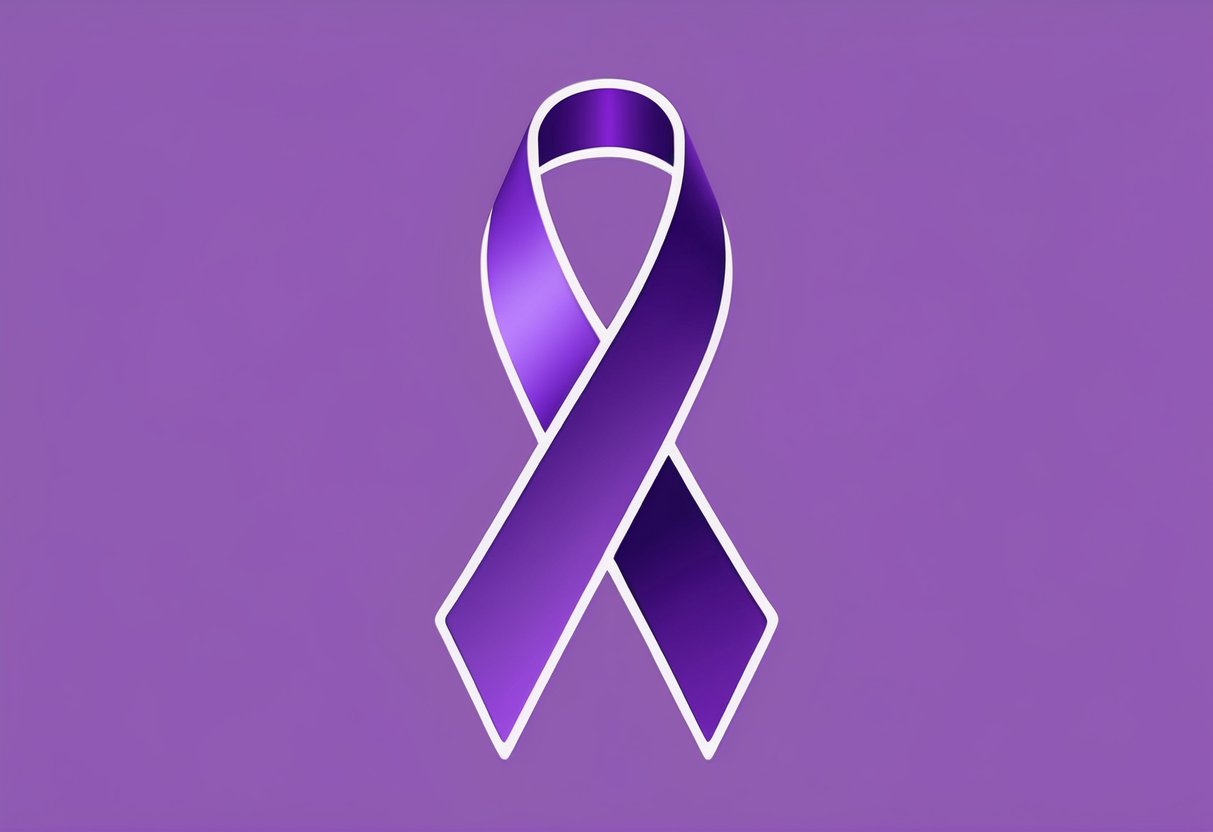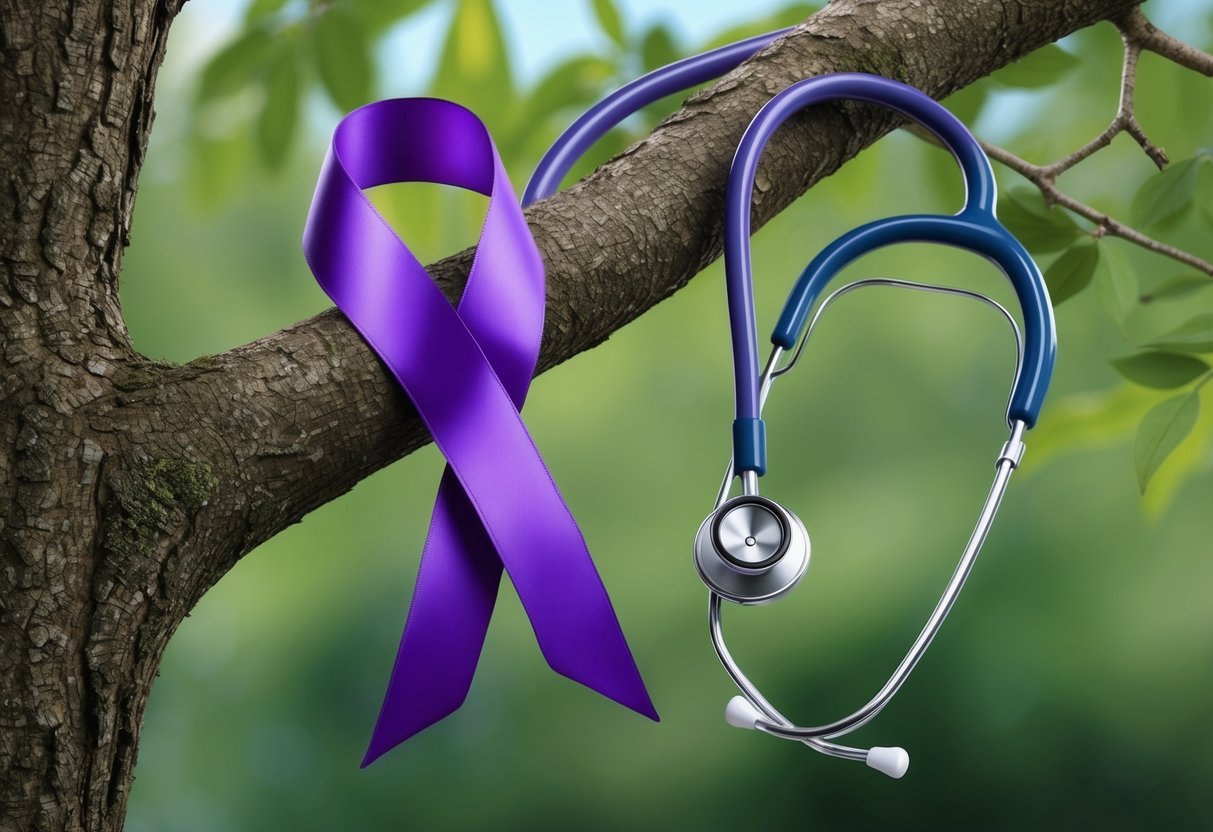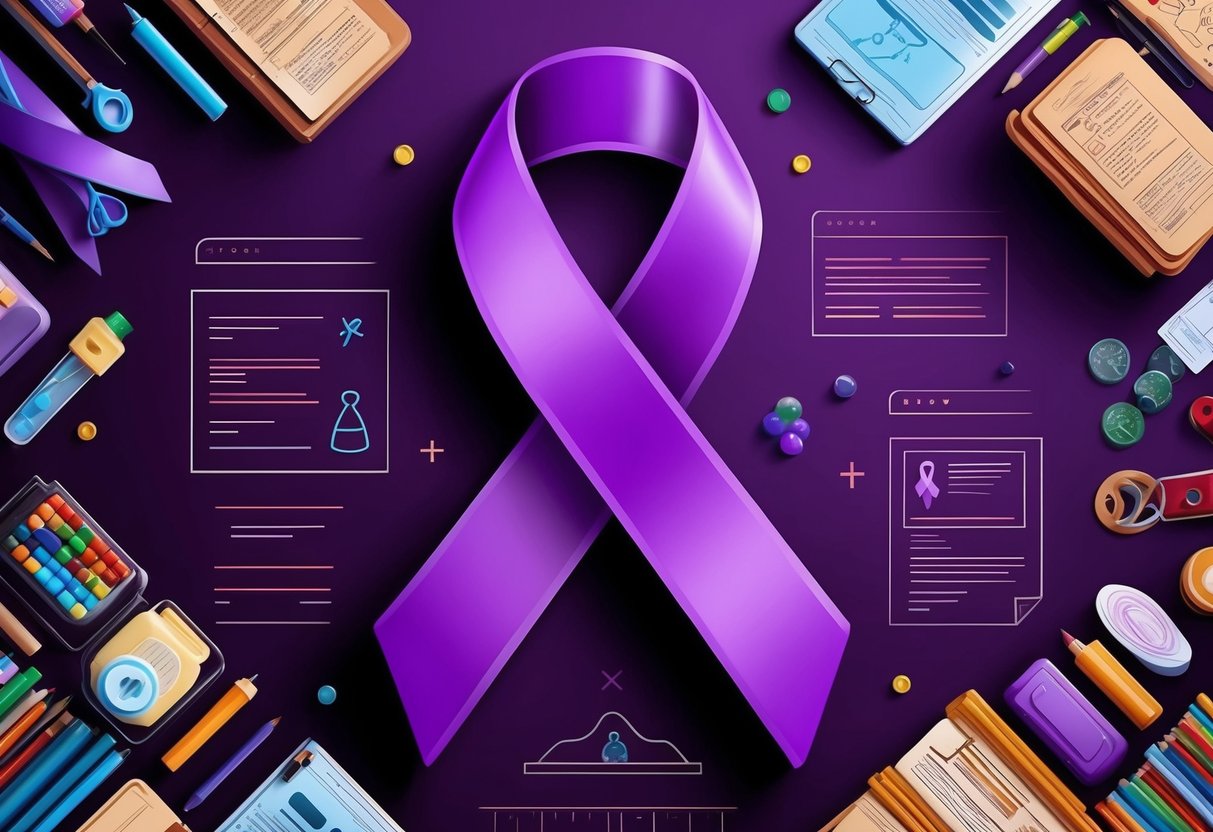When you see a purple ribbon, you might wonder what it stands for. A purple ribbon is a symbol of awareness for many important causes, including Alzheimer’s disease, domestic violence, epilepsy, lupus, and pancreatic cancer.
Its use in these contexts shows support for individuals affected by these conditions and raises public consciousness about them.
Comprehensive Table of Contents for Understanding the Purple Ribbon
The versatile use of the purple ribbon makes it a powerful tool in advocacy and solidarity. By wearing one, you join a larger community dedicated to spreading awareness and fostering change, whether it’s in support of victims, patients, or research efforts.
These ribbons serve not just as a sign of support, but also as a conversation starter. Understanding what a purple ribbon represents can open up discussions about the different challenges people face and how we can come together to address them.
Understanding Awareness Ribbons

Awareness ribbons are small, colorful loops of ribbons tied and worn to show support for a cause or issue. Each color is associated with specific concerns and raises public consciousness.
History of Awareness Ribbons
The use of awareness ribbons dates back decades, with one of the most recognized origins being the yellow ribbons tied for soldiers returning home from war. Over time, these ribbons evolved into symbols representing diverse causes and issues.
The proliferation of ribbon colors began in the late 20th century. Red ribbons became associated with AIDS awareness in the early 1990s. Eventually, ribbons became an accessible and widely recognized way to show solidarity. The movement has since expanded to include many colors, each with its own meaning and support for different causes, ranging from health issues to social concerns.
Purpose of Awareness Ribbons
Awareness ribbons function as tools for advocacy and education. By wearing or displaying a ribbon, you express support and bring attention to causes that matter to you.
These ribbons serve as conversation starters, prompting discussions that can lead to greater understanding and action. They also help unite communities around shared values or challenges. The simplicity of the ribbon makes it a powerful tool for visibility, enabling even those lacking resources to participate in advocacy.
With colors designated for various issues, awareness ribbons allow people to visually communicate their commitment to a cause, spreading awareness and fostering change in society.
Purple Ribbon Significance

The purple ribbon holds deep meaning across various areas. It is often linked to causes like epilepsy, pancreatic cancer, and domestic violence. By using purple ribbons, people aim to raise awareness and show support for different health and social issues.
General Symbolism
Purple ribbons are widely used in campaigns to show support and bring attention to significant issues. This color symbolizes strength, courage, and hope. Many organizations adopt purple ribbons as a visual sign to underline their mission.
This ribbon color is notable for bringing people together in their efforts to make a difference. Purple is also associated with dignity and perseverance, often appealing to those who seek to promote change.
Purple Ribbon Meaning
The meaning of a purple ribbon can vary based on the cause it represents. It is associated with a variety of health conditions, including epilepsy and pancreatic cancer. Purple also represents Alzheimer’s disease, lupus, and ADHD.
For social issues, purple ribbons are used to raise awareness about domestic violence and animal abuse. These ribbons serve as a reminder of the struggles faced specifically by those who have experienced these issues. By wearing or displaying purple ribbons, you can show support for these causes and bring them into the public eye.
Health and Disease Awareness

The purple ribbon symbolizes support for various health issues. Key areas include pancreatic cancer, Alzheimer’s disease, chronic illness, ovarian and brain cancer, and epilepsy.
Pancreatic Cancer Awareness
Pancreatic cancer is a serious illness that affects the pancreas, an organ vital for digestion and blood sugar regulation. Purple ribbons are symbolic of support for those battling this difficult condition. Early symptoms often go unnoticed, which can make it more challenging to treat.
Raising awareness is crucial for funding research and improving treatments. Many events and campaigns aim to educate the public about the significance of early detection and support for patients and their families.
Alzheimer’s Disease Support
Alzheimer’s disease is a progressive brain disorder affecting memory, thinking, and behavior. Wearing a purple ribbon shows your support for those facing this challenging illness. Alzheimer’s not only impacts the person diagnosed but also takes a toll on caregivers and families.
Supporting research and care initiatives is vital to finding effective treatments and coping strategies. Community walks and fundraising events often focus on promoting understanding and generating resources for this cause.
Chronic Illness Advocacy
Chronic illnesses are long-term health conditions that often require ongoing treatment and management. The purple ribbon represents support for individuals living with various chronic illnesses, which may include conditions like fibromyalgia and lupus.
Raising awareness helps to highlight the challenges faced by those with chronic illnesses, promoting empathy and understanding. Initiatives often focus on improving healthcare access and encouraging better support systems for affected individuals.
Ovarian and Brain Cancer Awareness
Both ovarian and brain cancers are serious conditions that may have profound effects on those diagnosed and their families. The purple ribbon serves as a reminder of the ongoing fight against these types of cancers.
Ovarian cancer is often detected late, making awareness and education essential for early diagnosis. Brain cancer can affect anyone and requires significant resources for treatment and support. Awareness campaigns aim to fund research and provide comprehensive support.
Epilepsy Awareness
Epilepsy is a neurological disorder characterized by recurrent seizures, affecting many people globally. A purple ribbon raises awareness and supports those living with this condition. Public understanding is essential to reducing stigma and ensuring proper care.
Many organizations focus on providing resources for treatment and support, as well as educating the public to improve responses during a seizure.
Social Advocacy and Support

The purple ribbon is a potent symbol used in various causes. It supports efforts against domestic violence and animal abuse, promotes suicide prevention, and honors military service and community efforts. Each cause represented by the purple ribbon aims to raise awareness and galvanize action for societal change.
Domestic Violence Awareness
Purple ribbons are widely recognized in the fight against domestic violence. They symbolize courage and survival and are used to raise awareness about the issue. By wearing or displaying a purple ribbon, you can show support for victims and survivors.
These efforts often involve events or campaigns in October, which is Domestic Violence Awareness Month. Educational outreach programs are key in teaching communities how to recognize and prevent domestic violence, encouraging safe environments.
Animal Abuse Prevention
The purple ribbon also serves as a reminder against animal abuse. It represents a commitment to treat animals ethically and humanely.
You might spot these ribbons during campaigns by animal rights organizations aiming to end cruelty to animals. These organizations often focus on rescuing mistreated animals and strengthening laws against abuse. Community events and educational materials spread the message that animals deserve protection, motivating you to report suspected abuse cases.
Suicide Prevention and Awareness
In the realm of mental health, the purple ribbon plays a vital role in suicide prevention and awareness. You can take part in initiatives that aim to support and provide resources to those at risk.
The ribbon symbolizes the importance of mental health conversations and encourages open dialogue. Various events to raise awareness are typically organized in September for National Suicide Prevention Month, aiming to educate the public and promote mental wellness.
Military and Community Support
The purple ribbon is also emblematic of efforts to support veterans and the military community. It reflects gratitude for service and acknowledges the sacrifices made by military personnel.
Programs that use this ribbon often focus on providing financial aid, healthcare, and educational benefits. Additionally, the purple ribbon can demonstrate unity within communities, inspiring civic participation and volunteerism to support both active duty members and veterans in adjusting to civilian life.
Comparisons with Other Ribbon Colors

Learning about different awareness ribbons helps you understand the variety of causes represented by colors. Each ribbon color symbolizes specific health issues, causes, and movements, with some being particularly well-known like the pink ribbon for breast cancer.
Red Ribbon Symbols
Red ribbons are widely recognized for their role in raising awareness about HIV/AIDS. They appear in events such as World AIDS Day to honor those affected by the disease.
Besides HIV/AIDS, red ribbons also symbolize support for heart disease awareness. February, which is American Heart Month, often features these ribbons as they draw attention to heart health.
Drunk driving awareness is another cause represented by red ribbons. These ribbons are used during campaigns to promote road safety and honor victims of road traffic accidents. The color red stands as a powerful reminder of the need for action and empathy in these areas.
Orange Ribbon Causes
Orange ribbons represent several important causes. One major use is raising awareness about leukemia, a type of blood cancer.
There are various events and activities where orange ribbons help show support for patients and research efforts in battling the disease.
Orange also stands for self-harm awareness. These ribbons are used to support individuals struggling with self-harm and to promote mental health awareness.
Cultural diversity and anti-racism are additional causes highlighted by the color orange. During different months or awareness campaigns, you might notice people wearing these ribbons to foster inclusion and understanding.
Yellow and Green Ribbon Meanings
Yellow ribbons have long been a symbol of support for military troops, especially those deployed abroad. They stand for hope and remembrance and are often tied to trees or worn during military-related events. This practice is deeply ingrained in cultural traditions linked to the military.
Green ribbons are age-associated with mental health awareness. They are used to promote conversations about mental health, reduce stigma, and encourage individuals to seek help.
Organ donation is another cause represented by green ribbons. They signify a person’s support for organ donation or to honor organ donors and recipients.
Blue, Teal, and Pink Ribbon Representations
Blue ribbons mark a variety of causes, including child abuse prevention. Typically seen during Child Abuse Prevention Month, these ribbons help raise awareness about the importance of protecting children.
Bullying prevention is another cause associated with blue ribbons, emphasizing the need to support and protect vulnerable individuals.
Teal ribbons often symbolize ovarian cancer awareness, focusing on supporting those affected by the disease and promoting research into its treatment. They are widely used during Ovarian Cancer Awareness Month to encourage donations and awareness.
Pink ribbons are best known for representing breast cancer awareness. They remind people of the importance of screening and research to combat this prevalent disease. During October, which is Breast Cancer Awareness Month, pink ribbons are displayed prominently to show solidarity and support for those battling breast cancer.
Raising Awareness Effectively

Awareness ribbons, particularly purple ones, can symbolize support for numerous causes like pancreatic cancer and epilepsy. Knowing how to effectively raise awareness is crucial to making an impact.
Organizing Awareness Events
Organizing awareness events can bring people together and spark conversations about important issues. You can start by picking a date that holds significance for the cause, like a related awareness month or day.
A successful event should engage participants. Workshops, guest speakers, and group discussions can offer informative and interactive experiences.
Don’t forget to use local media or social media platforms for promotion. Finally, supply attendees with materials like brochures or purple ribbon pins to wear. This helps participants spread the message beyond the event.
Using Color Combinations for Impact
Think creatively about color combinations to make awareness efforts stand out. Pairing purple ribbons with complementary colors can emphasize your cause even further.
You might use purple with silver to support Alzheimer’s awareness or with green for mental health concerns.
Consider using color in all the materials you distribute, such as posters or social media graphics. An eye-catching design can capture attention, encouraging people to learn more or participate in your cause.
By skillfully using colors, your message can reach a wider audience.
Support and Resources

Understanding the significance of a purple ribbon can connect you to a wealth of support services and educational materials. These resources can aid in fostering community support, advocacy, and deeper health awareness.
Finding Community Assistance
Connecting with others who share your interests is crucial. Local support groups and online forums offer spaces for sharing stories and advice.
Look for organizations focused on causes connected to purple ribbons, such as Alzheimer’s disease or pancreatic cancer.
In-person meetings and virtual groups can also provide support. Participating in events like charity walks or advocacy workshops helps build community ties.
These interactions often lead to discovering additional resources and support networks for your cause.
Educational Materials and Advocacy Tools
Accessing accurate information is essential for meaningful advocacy. Numerous organizations offer educational materials related to purple ribbon causes.
Brochures, videos, and webinars can provide insights into medical advancements and treatment options.
Toolkits for advocacy and awareness campaigns might include pamphlets and templates for contacting policymakers or media outlets.
Engaging with these resources empowers you to raise awareness more effectively. You can also attend seminars or workshops to learn how to utilize these tools for spreading information and supporting affected individuals.
Frequently Asked Questions

Purple ribbons convey various meanings, representing causes like cancer and domestic violence awareness, among others. The color’s significance varies by context, including its symbolic use within the LGBTQ community and in remembrance events.
What is the significance of the purple ribbon in various awareness campaigns?
You often see purple ribbons used to highlight important causes, such as Alzheimer’s disease, epilepsy, and pancreatic cancer. They are a symbol of hope and are used to spread awareness about these conditions and other issues like ADHD and domestic violence.
How does the dark purple ribbon differ from other awareness ribbon colors?
Dark purple ribbons are distinct because of their rich color, signifying strength and solidarity. Each awareness ribbon color generally represents different causes; purple stands out for its association with both medical conditions and social issues.
In what contexts is a purple ribbon used to symbolize remembrance?
Purple ribbons are sometimes used in memorials or events to honor loved ones lost to specific diseases, particularly those related to overdose and addiction. Their use in these contexts is meant to keep the memory of those affected alive.
What do the combined colors of teal and purple on a ribbon represent?
When teal and purple are combined, they often signify support for suicide prevention awareness. This color pairing brings attention to mental health struggles and encourages conversations about the importance of mental health care and support.
How does the meaning of a lavender ribbon differ from that of a purple ribbon?
Lavender ribbons can represent causes like all-cancer awareness, while purple ones are often linked with specific diseases or conditions. The subtle color difference indicates varying focuses within the broader health and social issues landscape.
What does the purple ribbon signify in LGBTQ communities?
In LGBTQ communities, a purple ribbon can signify spirit and courage. It symbolizes pride and the ongoing fight for equal rights. Recognizing this emblem helps promote tolerance and acceptance across diverse social groups.



